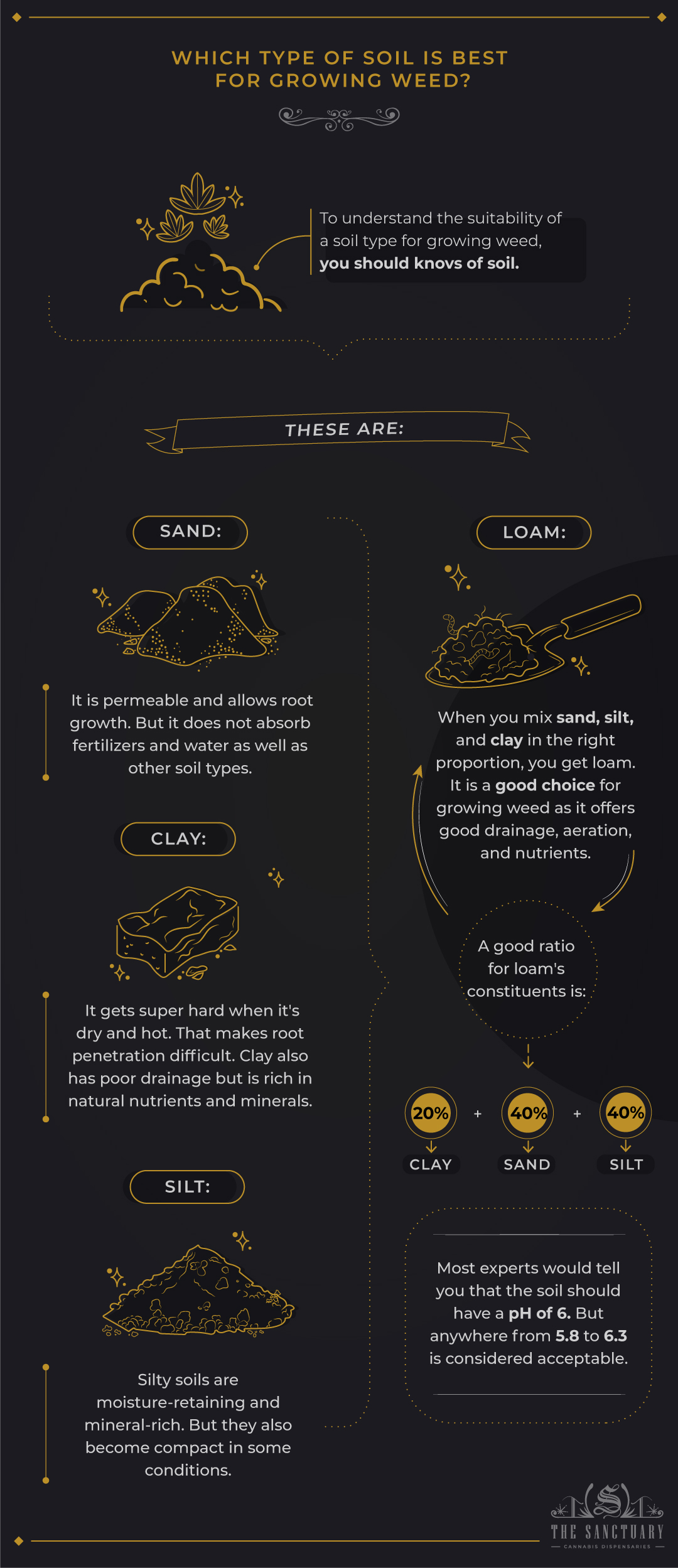Iftikhar Alam
Author
Reviewed by Cannabis Experts
Published on: June 30, 2023 | Updated on: September 11, 2024
From the correct type of seeds to the optimal growing conditions, the number of decisions you have to make when growing weed is downright overwhelming. But once you get the basics right, the process becomes easy.
One of the fundamental components of growing weed is using the right soil type. Let’s discuss which types of soils you can use to grow marijuana and which factors affect the soil’s fertility and growth potential.
Which Type of Soil Is Best for Growing Weed?

To understand the suitability of a soil type for growing weed, you should know about the four basic types of soil. These are:
- Sand: It is permeable and allows root growth. But it does not absorb fertilizers and water as well as other soil types.
- Clay: It gets super hard when it’s dry and hot. That makes root penetration difficult. Clay also has poor drainage but is rich in natural nutrients and minerals.
- Silt: Silty soils are moisture-retaining and mineral-rich. But they also become compact in some conditions.
- Loam: When you mix sand, silt, and clay in the right proportion, you get loam. It is a good choice for growing weed as it offers good drainage, aeration, and nutrients.
A good ratio for loam’s constituents is:
- 20% clay
- 40% silt
- 40% sand
Most experts would tell you that the soil should have a pH of 6. But anywhere from 5.8 to 6.3 is considered acceptable. If the soil you’ve chosen does not have the required acidity for weed growth, you’ll need to add soil amendments. We’ll talk about those later.
Attributes of Cannabis Growth-Friendly Soils
Remember that not all cannabis strains will grow well in loamy soils. Likewise, not every soil type can grow cannabis, either. Instead, you must select the soil type based on the cannabis strain and your area’s climate.
Here are other factors to consider when choosing the right soil type for cannabis growth.
- Texture: Cannabis plants require a loose soil texture. It helps promote root development by allowing more oxygen and nutrients to reach the plant’s roots.
- Drainage: Choose a soil type with excellent drainage. Here’s a simple test. When you pour water over the soil, it should not pool on the top of the soil surface. Instead, it should penetrate the soil quickly. Lack of proper drainage can kill or harm your cannabis plants.
- Water Retention: Not all the water should drain through the soil. Instead, the soil should have an optimal level of water retention capacity.
- pH Value: The pH determines the acidity or alkalinity of the soil. Cannabis plants do well in the pH range of 5.8 to 6.3. So opt for soil types within this pH range.
- Nutrients: Most commercial soils come with nutrients added to them. But these nutrients run out in a month or so. So, once your cannabis plant starts to flower, you’ll have to re-add nutrients.
Soil Amendments for Cannabis Growth
If you plan to skip commercial soil and opt for natural one instead, you’ll have to add a few soil amendments. The ones listed below are readily available at any local garden store.
Coco Coir
Coco fiber or coco coir improves the water retention capacity of the soil. It also helps lighten compact soils. You can use pure coco substrate or 30% coco air, based on how compact your base soil is.
Perlite
Perlite improves the soil’s airiness and drainage. Add 10% to 15% perlite to any base soil to enhance drainage and water retention. Don’t add too much perlite, as it may make the soil too light, allowing the nutrients and water to leach out.
Vermiculite
Like perlite, vermiculite also lightens the base soil and improves water retention. Around 10% vermiculite can prepare your base soil for cannabis growth. You can also use a mixture of perlite and vermiculite for best results.
Clay Pebbles
Add clay pebbles to the bottom of your soil-containing pot or container to improve drainage. It further prevents the pooling of water at the bottom of the container.
You can also put clay pebbles on the soil surface as mulch. In this location, clay pebbles reduce evaporation to trap moisture for the growing plant. They can also protect cannabis from hot sun rays.
Best Soil for Different Cannabis Plants
There are two main types of weed plants; autoflowering and photoperiod. The soil type you select for the seeds also depends on their type.
Autoflowering plants prefer light soil with few nutrients. A 50/50 mix of peat-based soil with coco coir added as an amendment can be ideal for autoflowering plants. If required, you can add perlite to improve drainage.
Do not use commercial soils with high fertilizer content when growing autoflowers. Avoid using soil amendments, such as bat guano, since they can overload the weed plant with excessive nutrients.
Meanwhile, photoperiod plants should be grown initially in small pots with nutrient-free or nutrient-deficient soils. Replant the plant in a larger pot once it becomes root bound. Now, the plant is mature enough to tolerate a higher nutrient level in the soil.
How to Make the Best Cannabis Soil At Home?
Here’s our simple recipe for making cannabis soil at home.
- 1 part coco coir peat
- 1 part vermiculite
- Two parts compost
- 1 cup humus or worm castings
These directions are for a 15L pot.
- Remove larger bits from your compost using a sieve or a filter.
- Follow the directions on the coco coir peat packet to check its volume. Soak it in water accordingly.
- Mix the vermiculite and coco coir peat.
- Add compost to the mixture.
Conclusion
You should not have trouble growing your favorite weed strain as long as you’ve got the right soil type and pH level. If the soil from your backyard is not doing the trick, opt for commercial soils.
Since these soils are already prepared, you must mix in the right organic matter and compost. After that, you simply have to sow the right seeds, water your plant, and wait for it to flower.
The content provided on this blog is for informational purposes only and does not constitute medical, legal, or professional advice. Cannabis use is subject to local laws and regulations, which vary widely by jurisdiction. Always consult with a healthcare professional before starting any new treatment or altering an existing treatment regimen. The authors and publishers of this blog are not responsible for any actions taken based on the information provided herein. Use cannabis responsibly and in accordance with applicable laws. This blog is intended for adults aged 21 and over. The Sanctuary Dispensaries D186, D187.








